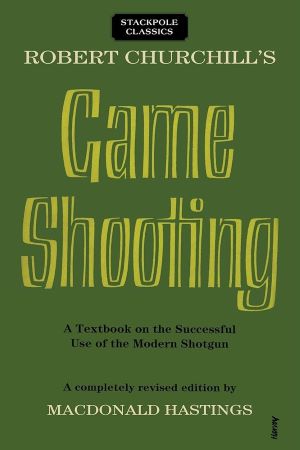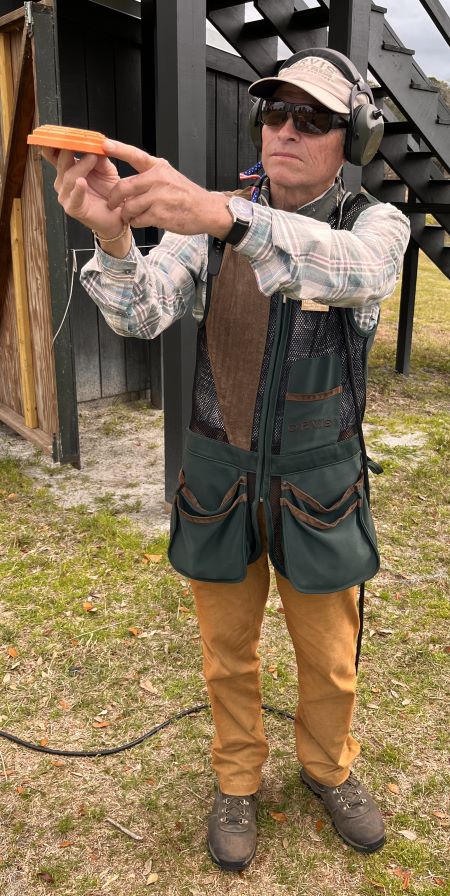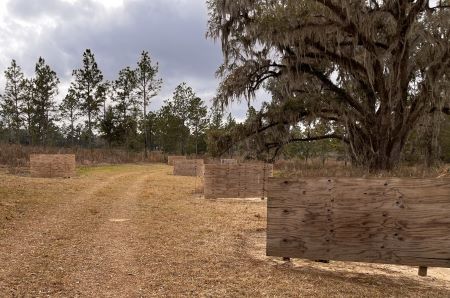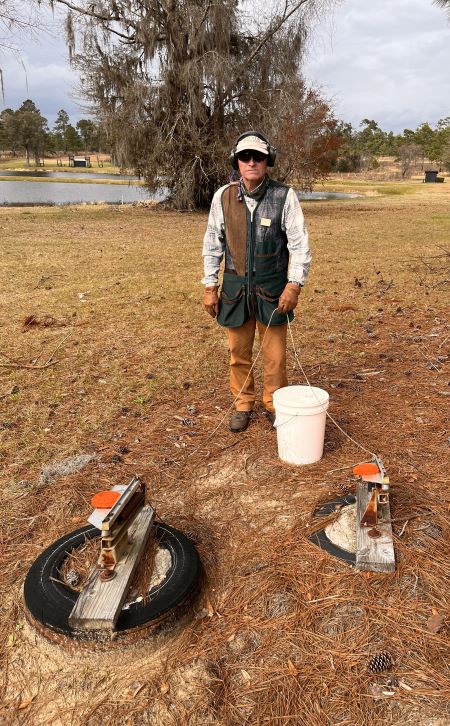Back to Basics with the Orvis Wingshooting School at the Mays Pond Sporting Grounds
Just because a clay target is called a “bird” doesn’t mean it has a brain, wings or instincts. For someone stepping from a skeet field into pheasant field it can be a humbling (and expensive) lesson to learn that the techniques and temperament acquired with clays shooting don’t automatically make us great wingshooters. Sometimes, after a disappointing performance on the prairies of North Dakota or the plantations of South Georgia, have put on our big-boy pants and admit it’s back to school.
Chances are that with a weathered tool bag of clays-shooting skills you’ll only need a tune-up to consistently bringing down those upland game birds – actually, fine-tuning the fundamentals summed up by the instructors as the Orvis Mays Pond Sporting Grounds in Monticello, Florida as “style.”

So if it’s getting back to basics that you really need, how about a first-class shooting grounds that actually uses hand-operated trap machines? If that sounds counter-intuitive, the Orvis Mays Pond Sporting Grounds has found those trap machines used by your granddaddy are, in fact, excellent bobwhite quail simulators during the Quail Walk portion of their wingshooting class. Why bobwhites? Because Montecillo is situated in the fabled Red Hills Region that spans nearly 1,000 square miles of North Florida and South Georgia plantations and preserves where you’ll find perhaps the best bobwhite quail habitat anywhere thanks in large part to ecology biologists and educators at Tall Timbers Research Station about 30 miles from the Mays Pond Sporting Grounds.
The uninitiated may be surprised to learn that Orvis also has wingshooting schools in upstate New York, Vermont, Alabama, Pennsylvania, North Carolina, Virginia, Mississippi and Nebraska. Many of those locations offer fly-fishing instruction as well, in addition to beautiful sporting clays courses and lodging. But the Mays Pond Sporting Grounds is all about the quail hunting and fly fishing.
Covering some 6,000 acres, Mays Pond is a showcase for pristine quail-hunting habitat. Except for the Orvis schools, Mays Pond represents one of the premier private shooting venues where the privilege to hunt comes by invitation only.

If you opt for the one- or two-day wingshooting classes at Mays Pond Sporting Grounds, lodging is available about 20 miles away in Tallahassee, Florida, or the true quail enthusiast will drive about 30 miles to Thomasville, Georgia (Shotgun Life’s home town). A Courtyard by Marriott is only two blocks from historic Thomasville with it’s first class gun store, boutiques and excellent restaurants and bars, as well as other nearby accommodations from Airbnb and VRBO. Proud of its quail-hunting heritage, a scavenger hunt challenges you to find the 18 bronze birds tucked away throughout downtown.
At the Mays Pond Sporting Grounds, the Orvis style of wingshooting is based on the method developed by Englishman Robert Churchill. Born in 1886, in addition to being a forensic ballistic expert and gunmaker (an advocate of 25-inch barrels), he became renowned for creating and popularizing the Churchill Method of instinctive wingshooting. Churchill dismissed the static rifle aiming technique handed down by generations in favor of instinct-driven moves free of conscious deliberation that allow the shooter to swing in harmony with his flying quarry.

Although Churchill refined his shooting technique over the years, it was the 1955 book “Robert Churchill’s Game Shooting” by Macdonald Hastings that spread the Churchill wingshooting gospel through Europe and America. Today, nearly every wingshooting and sporting-clays instructor will give lessons based on the Churchill Method.
Where rifle shooters consciously calculate a shot by looking down the barrel, it was Churchill who gave wingshooters permission to hold their shotgun in the so-called ready position with the butt slightly tucked into the armpit, for a two-eyed, 180-degree view of the landscape. The very definition of his instinctive method advocated mounting the gun during the swing and triggering the shot without conscious thought upon the stock meeting your face.
Churchill’s Method is based more on trust than computation. (Scientists have even detected in babies as young as nine months an ability to point at things of interest.) By placing trust in that pointing instinct, Churchill says that no forward allowance is required in pursuit of a bird, since we are born with the same pointing predispositions that helped our humanoid ancestors bring down wooly mammoths. In essence, we are already hard-wired to point at flying birds, but often undermine our natural born abilities with awful shooting habits, dubious instructions and a fixation on doodads.

How many times have you been shooting birds or sporting clays with friends and, upon missing, some well-meaning soul offers advice with the utmost confidence in the vein of “you’re behind it, you’re over it, too much lead…” and so on.
“We don’t talk about break points because we’re bird hunting,” said Truel Myers, Orvis’ head flying fishing instructor who is also a proficient wingshooting teacher.
Instead, as a key tenet of the Churchill Method, the instructors correct your “style” (it’s not a jab at your sartorial bravura).
“When we say good shot, it’s not that you broke the target, but it’s how to delivered the shot,” Truelnoted.
The 1963 revised edition of “Robert Churchill’s Game Shooting,” the book addresses style in its preface…
The reason that all of us do miss – much too often – is entirely the consequence of bad style. We drop our heads or fail to thrust the shoulder well into the gun. We shoot off balance through bad footwork. We fail to hold the barrels of the gun straight in the cup of the left hand. We ‘poke’ instead of swinging. We hang on to the trigger. Every miss is a fault in style. So much so that it is comparatively easy for an expert to tell whether a man has killed his bird or not simply by watching his gun handling and without looking at the target at all.
Come 1985, Bruce Bowlen had shared the sentiment in his book “The Orvis Wingshooting Handbook – Proven Techniques for Better Shotgunning” field gunners need a system that is simple, one that will allow them to successfully coordinate many variables in a split second. They need a technique that will utilize to full advantage the capabilities of eye and hand and require a minimum of thought.
Along with a shooting buddy who frequently returns to the Mays Ponds Sporting Grounds for refreshers, we had signed up for half-day class in wingshooting. Leading our session were Todd Rogers, lead wingshooting instructor at the Mays Pond Sporting Grounds and Truel Myers. I brought my 20-gauge Beretta Silver Pigeon II with 30-inch barrels custom fitted by Cole Gunsmithing in Naples, Florida.
The class starts with a safety briefing that not only concerns hunters but also the dogs and guides. Our shotguns had to be held at a high enough angle that wouldn’t put the dogs in jeopardy during an actual hunt.
My friend and I were assigned positions on either side of the wobble-trap machine covered by a large, raised platform. Our positions are intended to replicate a pair of hunters in the field with the random angles of the wobble trap simulating the unpredictability of flushing birds, as well as reinforcing the etiquette of shooting birds only in your quadrant (don’t poach the other hunter’s birds). The clays were set to fly, not as sporting-clays targets, but as quail mimicking a comparable elevation and speed.
Primarily, though, the wobble-trap exercise gives our instructors an opportunity to see how we shot as a baseline for our instructions.
“Mount it right the first time,” says Todd. “It’s about style. We want you to look good when you’re hitting or missing.”
Todd told me to slow down my gun mount. “Pretend you have a silver dollar on the rib and you don’t want it to fall off. Try not to shoot too soon. The bird needs to get established where it’s going. You have plenty of time, but don’t waste any of it.”
After shooting several boxes of shells, we climbed the steps of the platform. There were two stations with the clays coming from below thrown by the wobble trap. The purpose here was to concentrate on improving our focus by shooting at pieces. My buddy would shoot, (hopefully) break a target and I would need to identify a piece and hit it, and vice-versa.

Both the size of the piece and its erratic flight demanded high concentration and singular focus. You start by watching the target itself, but after the shot immediately turn your attention to a random shard – very much like a pair of birds busting from the undergrowth, only much smaller and faster. Imagine two birds flushing, one grabs your attention but suddenly you decide that the odds are better with the second bird and pivot.

From the platform we ambled over to the Quail Walk. It’s a layout of 10 stations in close proximity comprising 20 hand traps. The Quail Walk would be the culmination of the lessons we learned earlier in the day. Anywhere from one to four targets would be launched, but dived relatively quickly – leaving only a small window of opportunity to smash the clays before they dropped under your barrel. Having four targets thrown simultaneously from the hand traps is akin to as many flushing quail, forcing your instincts, focus, timing and “style” to coalesce into a seamless moment of impact.

“If you miss, stay with the same target,” Truel said.
We finally wrapped up our afternoon session, then hung around the beautiful grounds for some conversation under the trees.
Later, I realized that when we become dissatisfied with our wing or clays shooting, it seems that we automatically ratchet up the pressure to learn something new – trying to expand our foundation of learning on the rubble of misinformation and bad habits accumulated over the years. At Orvis’ Mays Pond Sporting Grounds, it became apparent that maybe the best way to improve our shooting is to take the road less traveled of revisiting the basics of our sport.
Irwin Greenstein is the publisher of Shotgun Life. You can reach him at https://www.linkedin.com/in/irwingreenstein
Resources:
The wingshooting schools page on the Orvis web site

Irwin Greenstein is Publisher of Shotgun Life. Please send your comments to letters@shotgunlife.com.


Comments